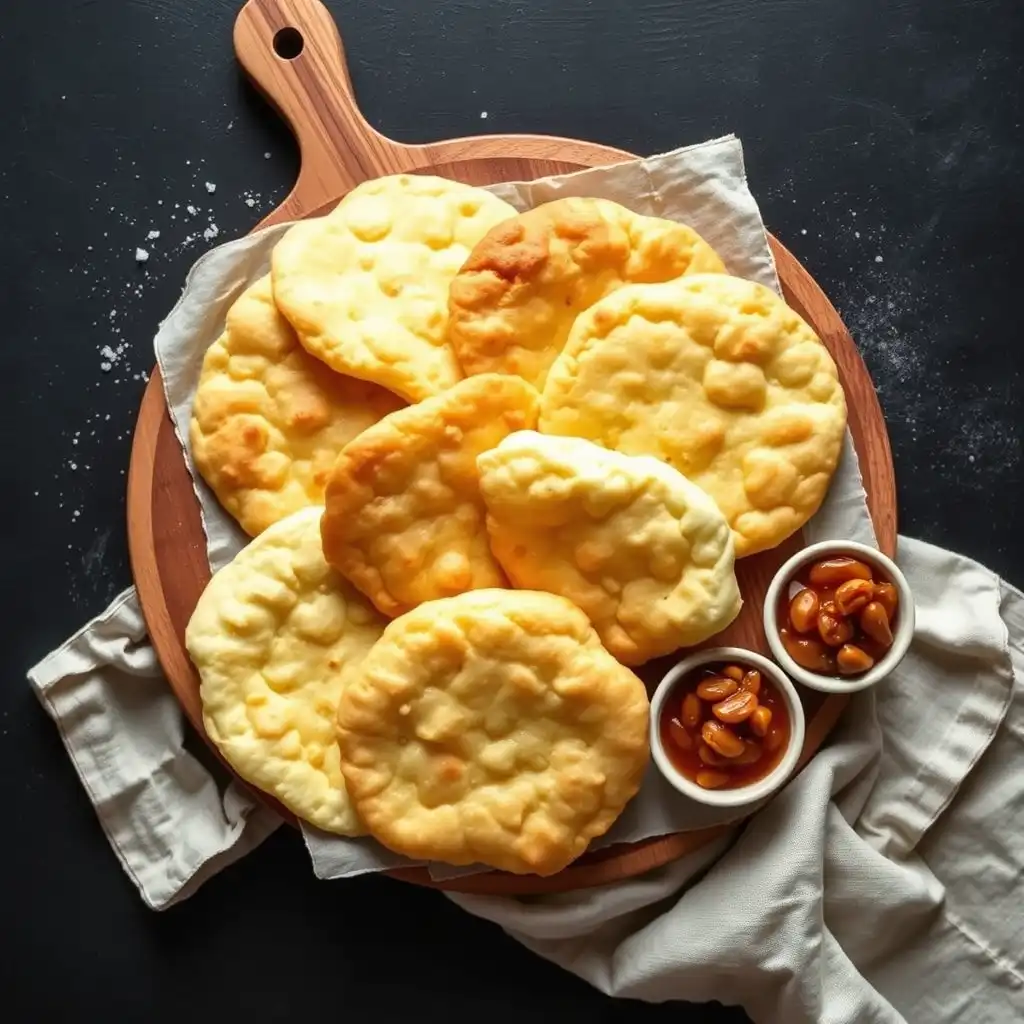Classic Fry Bread has a way of pulling you in before you even take a bite. Maybe it’s the smell, that warm scent of oil wrapping itself around flour and yeast like a hug you didn’t know you needed. Maybe it’s the memory, because everyone who’s had fry bread before seems to carry a story about it.
Classic Fry Bread is more than just a quick bread fried in oil. It’s a food born from survival and resilience, deeply rooted in Native American history, yet adaptable to every cook’s hands. Golden, puffy, and crisp on the outside, but soft and chewy inside—this is a bread that doesn’t ask for fancy techniques, but it does demand respect.
Classic Fry Bread thrives on simplicity. Just flour, salt, water, sometimes milk, and a little fat. Yet, with those humble things, it becomes something far bigger. You tear into it, steam lifts off, the surface crunches, and the inside is tender like a pillow that just barely holds its shape. It’s a paradox you can taste.
Ingredients & Substitutions
Classic Fry Bread begins with flour. All-purpose flour works just fine, but if you want a chewier bread with more structure, a higher-protein bread flour is worth reaching for. Both give different textures—bread flour makes it stretchy, all-purpose keeps it softer.
Classic Fry Bread usually calls for baking powder instead of yeast. That’s what makes it quick, giving it puff without waiting hours. But some cooks sneak in yeast for a slightly tangier flavor and a bit more chew. If yeast scares you, don’t bother—baking powder fry bread is the traditional route for most.
Classic Fry Bread needs liquid. Water is classic, but milk makes it richer, more tender, with a slightly darker crust after frying. If dairy’s an issue, oat milk or even almond milk work fine, though the taste shifts just a touch sweeter.
Classic Fry Bread asks for a little fat in the dough—shortening, lard, or butter. Lard makes it extra authentic with that deep, savory richness. Shortening gives a neutral profile, butter leans more European with its creamy notes. For vegan fry bread, coconut oil does the job, though it sneaks in its tropical whisper.
Classic Fry Bread fries best in oil with a high smoke point. Vegetable, canola, or peanut oil do well. Avoid olive oil—too strong, too low a smoke point, not worth the risk.
Step-by-Step Instructions
Classic Fry Bread starts with a bowl. Combine flour, baking powder, and salt first, mixing dry so it spreads evenly. This prevents those odd pockets where one bite tastes like pure salt and the next has none.
Classic Fry Bread needs the liquid added slowly. Pour in warm water or milk gradually, stirring with a wooden spoon or even your hand. The dough should come together shaggy, never soupy. Too wet and it sticks like glue, too dry and it cracks apart in the pan.
Classic Fry Bread dough shouldn’t be overworked. Knead gently, just until it comes together smooth. Three to four minutes of light kneading is enough. Push too far and the gluten tightens, leaving you with chewy rubber instead of airy pillows.
Classic Fry Bread must rest. Let the dough sit for 30 minutes, covered with a towel. This relaxes the gluten, makes it easier to roll, and allows the baking powder to spread its magic evenly. Skip this, and you’ll be fighting stubborn dough that shrinks back with every roll.
Classic Fry Bread shapes best when rolled or patted into circles about ¼ inch thick. Too thick, and the middle stays doughy. Too thin, and it turns into a cracker instead of bread. A little unevenness is part of its charm, don’t fuss over perfect circles.
Classic Fry Bread loves hot oil. Heat to 350°F (175°C)—any lower and it drinks the oil, becoming greasy, any higher and the outside burns before the inside cooks. A small scrap of dough should sizzle instantly but not smoke.
Classic Fry Bread fries quickly. Drop one piece at a time, don’t crowd the pan. About 2 minutes per side gives you that golden color. Flip once, never more. Constant flipping keeps it dense and soggy.
Classic Fry Bread drains best on a rack or paper towels. Sprinkle with a pinch of salt while still hot, the crystals cling better and wake up the flavor.
Cooking Techniques & Science
Classic Fry Bread puffs because of steam. The liquid inside heats fast, expands, and pushes the dough outward, while the hot oil locks the crust. That’s why resting and rolling thickness matter so much—the bread needs space inside to trap that steam.
Classic Fry Bread works better in cast iron. The even heat of cast iron keeps the oil temperature steady, which means consistent frying. Thin pans cause fluctuations, leaving you with pale greasy spots.
Classic Fry Bread depends on gluten. Even though you knead lightly, that small gluten structure is what holds the puff. If you used cake flour, the bread would collapse. If you used straight bread flour, it might be too tough. Balancing flour types gives control.
Classic Fry Bread burns easily if oil isn’t refreshed. After several rounds, flour and crumbs settle at the bottom and darken the oil. Strain it if needed, or switch to fresh before the taste turns bitter.
Classic Fry Bread never benefits from overcrowding. Too many pieces lower the oil temp, and instead of frying, they steam. That leads to soggy bread that feels heavy instead of light. Always give the dough its space, just like people in an elevator.
Serving & Pairing Suggestions
Classic Fry Bread can be sweet. Dust with powdered sugar, drizzle honey, or spread jam over it. It takes on sweetness like a canvas, always welcoming without overpowering.
Classic Fry Bread can be savory. Top with beans, taco fillings, shredded beef, or just a brush of garlic butter. The chewy crunch stands up to heavy toppings without falling apart.
Classic Fry Bread serves beautifully beside soups and stews. A bowl of chili with fry bread for dipping turns into a meal that feels endless in comfort.
Classic Fry Bread plates well if torn by hand at the table. That rustic look, jagged edges and all, reminds diners this is food with history. Avoid cutting into neat wedges—it loses that raw soul.
Classic Fry Bread pairs with drinks that cut the richness. Iced tea, lemonade, or even a crisp lager balance the fried edge, refreshing the palate.
Conclusion
Classic Fry Bread is more than fried dough. It’s history carried in a skillet, survival turned into sustenance, and simplicity elevated into something iconic. Every puff and golden blister tells a story of resourcefulness, family, and comfort.
Classic Fry Bread asks for patience but not perfection. A little too round, a little too lopsided—none of it matters once you taste the crisp edge and tender middle. The lesson is the same as the food: simple, but never plain.
Classic Fry Bread belongs in every cook’s repertoire. Whether served sweet, savory, or plain with a cup of coffee, it brings people together. And really, isn’t that what bread has always been for?
FAQs
What kind of flour is best for fry bread?
All-purpose flour is most common, but bread flour makes it chewier. A mix of the two can balance softness and structure.
Can fry bread dough be made ahead of time?
Yes, but it’s best within a few hours. Store covered in the fridge, and let it come back to room temp before rolling and frying.
Why is my fry bread greasy?
The oil was too cool. Keep it around 350°F so the bread fries fast instead of soaking up fat.
How do I keep fry bread soft after cooking?
Wrap it in a towel once it cools slightly. This traps steam, keeping the interior tender.
Can I bake fry bread instead of frying?
You can, but it won’t be authentic. Baking gives a flat, dense bread instead of the signature puff and crisp edges.

Olivia P. is a seasoned food blogger at Tastywink, sharing delicious, easy-to-follow recipes inspired by him passion for home cooking. With years of culinary blogging experience, he brings flavor, creativity, and a personal touch to every dish.
